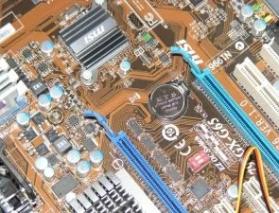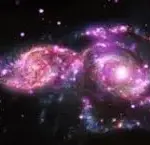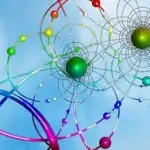 Our universe began with an explosion of energy; from this explosion, some of the energy rapidly condensed into elementary particles like quarks and electrons. Quarks have a property called color – they come in colors red, blue, and green. And each color has an anti-color. Much like with ordinary colored light, the colors red, blue, and green add up to white. And any color and its anti-color add up to white. Many combinations of quarks are possible. When quarks combine, their color-combinations form patterns.
Our universe began with an explosion of energy; from this explosion, some of the energy rapidly condensed into elementary particles like quarks and electrons. Quarks have a property called color – they come in colors red, blue, and green. And each color has an anti-color. Much like with ordinary colored light, the colors red, blue, and green add up to white. And any color and its anti-color add up to white. Many combinations of quarks are possible. When quarks combine, their color-combinations form patterns.
These color-patterns are not mere regularities into which particle combinations just happen to occur. They do not emerge from chance, like the statistical regularities that emerge when you roll dice. These patterns are natural necessities; as such, it is appropriate to call them laws. The laws of nature are objectively existing patterns of necessity. They are not the opinions of either humans or gods. The logic of necessity (and possibility) is known as modal logic. So the laws of color-combination involve modality.
The laws of color-combination state that when quarks combine into a particle, their colors must add up to white and must not add up to any other color. Quarks are free to combine in ways that produce neutral white and are not freeto combine otherwise. These laws entail two two types of possible quark combinations: those that obey the laws of color-combination and those that violate those laws. Here the concepts like obedience and violation have nothing to do with mentality or will. They remain purely logical concepts, associated with the logic of possibility and necessity.
Modal logic includes the deontic logic, which is the logic of the forbidden and the obligatory. The behaviors of quarks satisfy the rules of deontic logic. And because they satisfy those rules, it is appropriate to apply the concepts of deontic logic to quarks. The laws of color-combination entail that quarks are forbidden to combine into wholes with non-white color and are obligated to combine into wholes with white color. The neutralization of color-charge of any whole composed of quarks has normative force. The laws of color-combination define the norms of quark congregation.
The quarks literally satisfy those rules; they do not satisfy them in some metaphorical way. Hence saying that quarks are obligated to combine in a certain way is not just a convenient manner of speaking. The obligation is not a fiction projected by humans onto the world of quarks. The patterned behaviors of quarks objectively satisfy the rules of deontic logic. Quarks have deontic competence without having any comprehension of their competence. They have competence without comprehension. Moreover, deontic logic is also the logic of duty. When they combine, the quarks have a duty to neutralize color. And, since quarks do not depend on any simpler components which might prevent them from doing their duties, they always do their duties.
When some parts combine in obligatory ways into more complex wholes, the satisfaction of that obligation entails the emergence of some intrinsic value. This value is intrinsic because it does not depend on any observers or evaluators. It is objectively existing value; it is natural value. Intrinsic value is a physical property of things. It is just as physical as mass, charge, or spin. Since intrinsic value first emerges as simples join into complexes, it follows that intrinsic value corresponds to complexity. Complexity is an objectively existing physical property. It is a natural property of wholes.
As simple things, quarks have zero intrinsic value; but when three of them satisfy an obligation and so combine, the whole acquires intrinsic value. Thus quark-combinations (like protons and neutrons) are the first things with any positive intrinsic value. And when quarks combine, they exchange particles known as gluons. These exchanges are reciprocal. Since they come together in value-creating ways, and since their sustained combination depends on reciprocal exchanges, the combination of quarks into more complex particles is cooperative. Since value emerges when quarks combine into more complex particles, it is good for quarks to combine. Since value is lost when those complex particles disintegrate, it is bad for the complex particle to disintegrate.
Protons and neutrons combine to form atomic nuclei. When they combine, a whole with greater complexity emerges. Since new quantum properties appear when protons and neutrons join into a nucleus, the nucleus is a whole that is distinct from the mere sum of its parts. A new kind of thing emerges. This is real emergence, which can be quantified mathematically. Here again the union of parts into wholes increases intrinsic value. And since the whole emerges from its parts, and is not merely their sum, the value of that whole is greater than the sum of the value of its parts. When combined into some nucleus, the protons and neutrons exchange particles called mesons. This is also reciprocal exchange. The protons and neutrons cooperate to make the nucleus. As before, it is good for the protons and neutrons to combine; it is bad for the nucleus to fall apart.
The cores of stars fuse simpler nuclei into more complex nuclei. Since more complex nuclei have greater intrinsic value, it is good for the particles in the simpler nuclei to be fused into more complex nuclei. On the other hand, since the fusion destroys the simpler nuclei, it is bad for the simpler nuclei to fuse. This is the first emergence of conflict between the goods of parts and the goods of their wholes. A long tradition defines evils as conflicts among goods. So evil first emerges in the hearts of stars. When stars form more complex nuclei, some of them are stable while others are unstable. The unstable nuclei disintegrate through atomic decay. Since wholes have intrinsic value, it is good for any whole to persist. Hence stability is a good for any whole. Here again deontic logic applies: it is axiomatic that value should not be destroyed and ought to be preserve. Stable nuclei are better at doing what they ought to do. When something is better at doing what it ought to do, that competence is virtuous. Stability is a virtue; instability is a vice.
Atomic nuclei combine with simple electrons to make atoms. From these combinations, greater complexity emerges. So greater intrinsic value also emerges. Hence this combination is also cooperation. Each particle in the atom pursues its own good; but these goods do not conflict with each other. But the bonds between nuclei and their electrons are already much weaker. Atoms combine to form molecules. They combine by sharing electrons (by covalent bonding). Covalent bonds are much weaker than the bonds among particles. The particles in atoms have their own goods; but the whole atom also has its own good. Since the covalent bonds are weaker, there are more opportunities for conflict in the combinations of atoms into molecules.
When atoms combine into molecules, they share their electrons. The octet rule in chemistry states that many types of atoms tend to combine in ways that give them all eight valence electrons. The octet rule regulates atoms much like the color-charge rule regulates quarks. But the bonds among atoms are much weaker than those among quarks. Although the octet rule exerts normative force, its force is not obligatory. The octet rule entails that atoms prefer to combine to have eight valence electrons. A molecule whose atoms combined according to the octet rule is more stable. Since stability is good for any whole, atoms pursue this good; they seek to obtain eight valence electrons. Hence atoms compete with each other to form molecules in which they satisfy the octet rule. The competitive forces between molecules drive them to tear each other apart to form more stable molecules. This is a primitive kind of conflict. Hence it is a primitive kind of evil; but more complex wholes emerge from this conflict; evil generates good.
Populations of lifeless molecules self-organize to become living cells. They mostly bond very weakly through the van der Waals force. Within the cell, every molecule pursues its own goods. These pursuits combine so that the cell pursues its own good. The conflicts between molecules are converted into cooperation at a higher level of complexity. Thus molecular evils are constrained by each other to generate a higher-level cellular good. But the bonds among molecules are weak. Hence their goods may easily diverge from the good of the cellular whole. Cells fall victim to molecular civil wars and insurrections. They lose their harmonies; they disintegrate and die. Yet some sets of cells self-organize into complex multicellular organisms. Every system of interacting cells strives to maximize its internal harmony; it strives to maximize the aesthetic value of its flows of energy; it strives for biological beauty; it strives for vital musicality. Consequently, it strives to be healthy. It strives to maximize its dynamic functionality.
As things become more complex, their own strivings for their own goods become more intense; and their bonds grow weaker. Consequently, as wholes contain greater levels of internal organization, they are more exposed to internal dissent. Since their parts strive ever more intensely for their own independent goods, those parts become more competitive. As they compete, their opposed strivings create conflicts. These strivings emerge in the cells of organisms. For any cell, the ultimate good is endless self-reproduction. Every cell adopts the policy: reproduce endlessly! But when cells come together to form organisms, they fit their goods into the good of the whole. This fitting constrains their striving for endless self-reproduction. This constraint is a conflict within the cell. It is materiality with in the cell. And since every cell still pursues its good, every cell still tries to break free from this constraint. When cells break their constraints, they become cancerous. At the cellular level, cancer is good. But at the organism level, cancer is evil. Cancer entails a civil war in the organism. It kills the organism. Evil emerges when the cooperative bonds among parts are too weak to constrain the strivings of the parts for their own goods. Hence the parts enter into civil war. They destroy the whole.
As live evolves, it differentiates into multiple species. As they interact with each other, cooperative and competitive relations emerge. Plants interact with microbes at their roots. Plants are good at producing carbon but need nitrogen; while the microbes are good at fixing nitrogen but need carbon. Biological diversity entails a possibility for cooperation. Plants and microbes benefit if they exchange their products. Each flourishes more if they reciprocate. At first, they may make accidental exchanges. But repeated interaction leads to entanglement: they begin to depend on each other. This mutual dependence is partnership (mutualism, symbiosis). By cooperating, the plants and microbes form a more complex communal organism. Greater intrinsic value emerges.
When they become partners, and start to exchange molecules, their interactions form a game-theoretic matrix. They have cooperative competence and then game-theoretic competence. They need not have any awareness to do have these competencies; they have competence without comprehension. They form a social contract. They literally make promises to each other. When they interact game-theoretically, two policies become available to each partner: cooperate or defect. Here cooperation means equal exchange while defecting means less than equal exchange. Defecting is cheating.
Cheating first emerges in the exchanges or organisms. And with the evolution of cheating, principles to oppose it also evolve. These are the first moral principles. One of these moral principles is the categorical imperative articulated by Kant. Given multiple policies, the categorical imperative sorts them into the obligatory, the permissible, and the forbidden. Kant used the categorical imperative to rule out cheating (promise-breaking, stealing, etc.). Any microbe can apply the categorical imperative to its own policies. The categorical imperative works via universalization. If all microbes cheat, what happens? What happens is the destruction of the cooperative symbiosis. But cheating depends on that symbiosis. So cheating is practically self-contradictory. It is self-refuting (or unstable) when universalized. And those partnerships with cheaters flourish less; they are less likely to thrive, to survive, and to reproduce. So natural selection weeds them out. Natural selection implements the categorical imperative.
The categorical imperative prohibits or forbids those policies that destroy accumulated complexity and value. Consider a community of cooperating organisms. By working together, they create a social whole with greater complexity and value. Thus many simple amoeba self-organize into a far more complex slime mold. By working together, many bees self-organize into a far more complex hive. And by working together, many humans self-organize into extremely complex societies (which produce complex cultural and technological artifacts). By following only those policies which are stable under universalization, a community of cooperators retains its own stability.
The categorical imperative prohibits policies which lead to the destruction of cooperation. It prohibits the emergence of cheaters and free-riders, who take advantage of cooperation without cooperating. So the categorical imperative acts like a ratchet which prevents the society of cooperators from backsliding to lower complexity. It prevents the disintegration of complex wholes into simpler disorganized components. So the categorical imperative forbids policies which destroy complex value. By preventing the destruction of accumulated complexity, the categorical imperative preserves accumulated complexity. By prohibiting policies which destroy complexity, the categorical imperative ensures the minimization of self-inconsistency. It obligates policies which preserve complex value; and it permits policies which increase complex value.
Thus morality emerges with cooperators. And with that morality, moral duties evolve: the plant and microbes ought to cooperate; they should not cheat. Further support for the regulative force of the categorical imperative in symbiosis comes from the fact that cooperators have evolved mechanisms for detecting and punishing cheaters. And they should punish them. The plant and microbe do not merely occupy physical space; they also occupy game-theoretic space, which is the game-theoretic matrix of their possible interactions and their possible policies. From their repeated interactions, a normative force emerges, and it pushes them towards cooperation. It pushes them towards the cooperate-cooperate region of game space. More positively, the categorical imperative commands each partner to cooperate. It generates a normative force which pushes each partner to the cooperate-cooperate region. Hence the Golden Rule emerges as a norm. Each partner ought to follow the Golden Rule: do unto your partner as you would have your partner do unto you. The Golden Rule is game-theoretically stable.
Although rules against cheating emerge in all systems of cooperators, those rules depend on the strengths of the bonds among the cooperators. And as cooperators gain complexity, those bonds grow weaker. Thus cheating becomes self-sustaining. As it becomes self-sustaining, competitive ecological relations emerge.
Many ecological relations are competitive. Bacteria strive for their own goods; their strivings conflict with the strivings of their hosts. More generally, parasites and hosts both strive for their own goods; predator and prey both strive for their goods; but these strivings lead to deadly conflict. The cheetah ought to run faster to catch the gazelle; the gazelle ought to run faster to escape the cheetah. This conflict drives evolution by natural selection. The struggle for existences drives the survival of the fittest. Among competitors, normative forces drive evolutionary arms races. These arms races produce much of the arete of the living world. And this violent struggle for survival drives life to become more valuable, more highly functional, more diverse, more beautiful. All struggle is ultimately (though not proximately) for the best. Although ecological competition creates suffering, it generates greater goods. Nature is not utilitarian: it values arete, not happiness.
Populations of animals self-organize to become societies. As they self-organize, they develop strategies for interaction. Game-theoretic strategies like tit-for-tat outcompete less cooperative strategies. Hence the selfish desires of individuals lead to the emergence of altruism. Honeybees and their flowers cooperate to form a social system regulated by moral and political norms. Social insects cooperate to form political organizations. Birds interact politically. Wolves form packs regulated by political norms. Non-human primates form complex cooperative societies. The natural world, long before the emergence of humans, is saturated with value and morality.
Subscribe to The Spiritual Naturalist Society
Learn about Membership in the Spiritual Naturalist Society
__________
The Spiritual Naturalist Society works to spread awareness of spiritual naturalism as a way of life, develop its thought and practice, and help bring together like-minded practitioners in fellowship.












